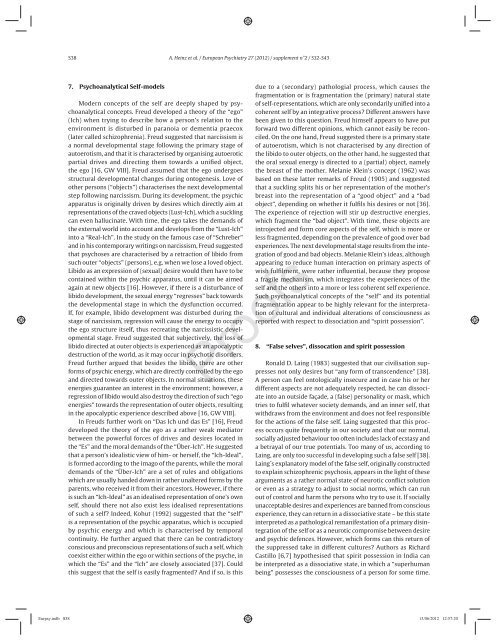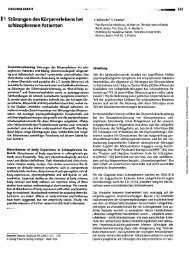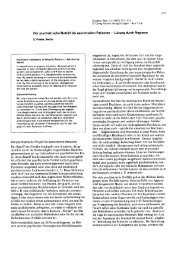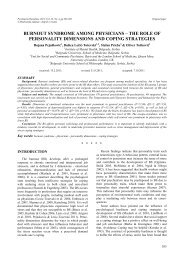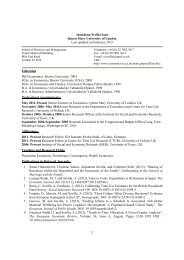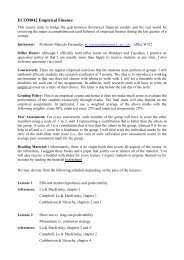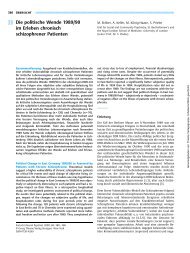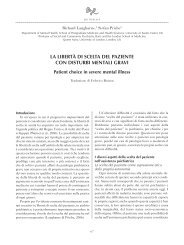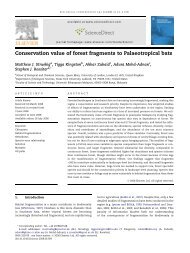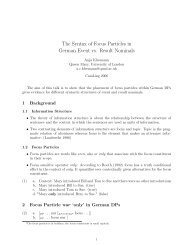Proofs - Personal Webspace for QMUL - Queen Mary, University of ...
Proofs - Personal Webspace for QMUL - Queen Mary, University of ...
Proofs - Personal Webspace for QMUL - Queen Mary, University of ...
You also want an ePaper? Increase the reach of your titles
YUMPU automatically turns print PDFs into web optimized ePapers that Google loves.
S38 A. Heinz et al. / European Psychiatry 27 (2012) / supplement n°2 / S32-S43<br />
7. Psychoanalytical Self- models<br />
Modern concepts <strong>of</strong> the self are deeply shaped by psychoanalytical<br />
concepts. Freud developed a theory <strong>of</strong> the “ego”<br />
(Ich) when trying to describe how a person’s relation to the<br />
environment is disturbed in paranoia or dementia praecox<br />
(later called schizophrenia). Freud suggested that narcissism is<br />
a normal developmental stage following the primary stage <strong>of</strong><br />
autoerotism, and that it is characterised by organising autoerotic<br />
partial drives and directing them towards a unifi ed object,<br />
the ego [16, GW VIII]. Freud assumed that the ego undergoes<br />
structural developmental changes during ontogenesis. Love <strong>of</strong><br />
other persons (“objects”) characterises the next developmental<br />
step following narcissism. During its development, the psychic<br />
apparatus is originally driven by desires which directly aim at<br />
representations <strong>of</strong> the craved objects (Lust- Ich), which a suckling<br />
can even hallucinate. With time, the ego takes the demands <strong>of</strong><br />
the external world into account and develops from the “Lust- Ich”<br />
into a “Real- Ich”. In the study on the famous case <strong>of</strong> “Schreber”<br />
and in his contemporary writings on narcissism, Freud suggested<br />
that psychoses are characterised by a retraction <strong>of</strong> libido from<br />
such outer “objects” (persons), e.g. when we lose a loved object.<br />
Libido as an expression <strong>of</strong> (sexual) desire would then have to be<br />
contained within the psychic apparatus, until it can be aimed<br />
again at new objects [16]. However, if there is a disturbance <strong>of</strong><br />
libido development, the sexual energy “regresses” back towards<br />
the developmental stage in which the dysfunction occurred.<br />
If, <strong>for</strong> example, libido development was disturbed during the<br />
stage <strong>of</strong> narcissism, regression will cause the energy to occupy<br />
the ego structure itself, thus recreating the narcissistic developmental<br />
stage. Freud suggested that subjectively, the loss <strong>of</strong><br />
libido directed at outer objects is experienced as an apocalyptic<br />
destruction <strong>of</strong> the world, as it may occur in psychotic disorders.<br />
Freud further argued that besides the libido, there are other<br />
<strong>for</strong>ms <strong>of</strong> psychic energy, which are directly controlled by the ego<br />
and directed towards outer objects. In normal situations, these<br />
energies guarantee an interest in the environment; however, a<br />
regression <strong>of</strong> libido would also destroy the direction <strong>of</strong> such “ego<br />
energies” towards the representation <strong>of</strong> outer objects, resulting<br />
in the apocalyptic experience described above [16, GW VIII].<br />
In Freuds further work on “Das Ich und das Es” [16], Freud<br />
developed the theory <strong>of</strong> the ego as a rather weak mediator<br />
between the powerful <strong>for</strong>ces <strong>of</strong> drives and desires located in<br />
the “Es” and the moral demands <strong>of</strong> the “Über- Ich”. He suggested<br />
that a person’s idealistic view <strong>of</strong> him- or herself, the “Ich- Ideal”,<br />
is <strong>for</strong>med according to the imago <strong>of</strong> the parents, while the moral<br />
demands <strong>of</strong> the “Über- Ich” are a set <strong>of</strong> rules and obligations<br />
which are usually handed down in rather unaltered <strong>for</strong>ms by the<br />
parents, who received it from their ancestors. However, if there<br />
is such an “Ich- Ideal” as an idealised representation <strong>of</strong> one’s own<br />
self, should there not also exist less idealised representations<br />
<strong>of</strong> such a self? Indeed, Kohut (1992) suggested that the “self”<br />
is a representation <strong>of</strong> the psychic apparatus, which is occupied<br />
by psychic energy and which is characterised by temporal<br />
continuity. He further argued that there can be contradictory<br />
conscious and preconscious representations <strong>of</strong> such a self, which<br />
coexist either within the ego or within sections <strong>of</strong> the psyche, in<br />
which the “Es” and the “Ich” are closely associated [37]. Could<br />
this suggest that the self is easily fragmented? And if so, is this<br />
due to a (secondary) pathologial process, which causes the<br />
fragmentation or is fragmentation the (primary) natural state<br />
<strong>of</strong> self- representations, which are only secondarily unifi ed into a<br />
coherent self by an integrative process? Different answers have<br />
been given to this question. Freud himself appears to have put<br />
<strong>for</strong>ward two different opinions, which cannot easily be reconciled.<br />
On the one hand, Freud suggested there is a primary state<br />
<strong>of</strong> autoerotism, which is not characterised by any direction <strong>of</strong><br />
the libido to outer objects, on the other hand, he suggested that<br />
the oral sexual energy is directed to a (partial) object, namely<br />
the breast <strong>of</strong> the mother. Melanie Klein’s concept (1962) was<br />
based on these latter remarks <strong>of</strong> Freud (1905) and suggested<br />
that a suckling splits his or her representation <strong>of</strong> the mother’s<br />
breast into the representation <strong>of</strong> a “good object” and a “bad<br />
object”, depending on whether it fulfi ls his desires or not [36].<br />
The experience <strong>of</strong> rejection will stir up destructive energies,<br />
which fragment the “bad object”. With time, these objects are<br />
introjected and <strong>for</strong>m core aspects <strong>of</strong> the self, which is more or<br />
less fragmented, depending on the prevalence <strong>of</strong> good over bad<br />
experiences. The next developmental stage results from the integration<br />
<strong>of</strong> good and bad objects. Melanie Klein’s ideas, although<br />
appearing to reduce human interaction on primary aspects <strong>of</strong><br />
wish fulfi lment, were rather infl uential, because they propose<br />
a fragile mechanism, which integrates the experiences <strong>of</strong> the<br />
self and the others into a more or less coherent self experience.<br />
Such psychoanalytical concepts <strong>of</strong> the “self” and its potential<br />
fragmentation appear to be highly relevant <strong>for</strong> the interpretation<br />
<strong>of</strong> cultural and individual alterations <strong>of</strong> consciousness as<br />
reported with respect to dissociation and “spirit possession”.<br />
8. “False selves”, dissocation and spirit possession<br />
<strong>Pro<strong>of</strong>s</strong><br />
Ronald D. Laing (1983) suggested that our civilisation suppresses<br />
not only desires but “any <strong>for</strong>m <strong>of</strong> transcendence” [38].<br />
A person can feel ontologically insecure and in case his or her<br />
different aspects are not adequately respected, he can dissociate<br />
into an outside façade, a (false) personality or mask, which<br />
tries to fulfi l whatever society demands, and an inner self, that<br />
withdraws from the environment and does not feel responsible<br />
<strong>for</strong> the actions <strong>of</strong> the false self. Laing suggested that this process<br />
occurs quite frequently in our society and that our normal,<br />
socially adjusted behaviour too <strong>of</strong>ten includes lack <strong>of</strong> ecstasy and<br />
a betrayal <strong>of</strong> our true potentials. Too many <strong>of</strong> us, according to<br />
Laing, are only too successful in developing such a false self [38].<br />
Laing´s explanatory model <strong>of</strong> the false self, originally constructed<br />
to explain schizophrenic psychosis, appears in the light <strong>of</strong> these<br />
arguments as a rather normal state <strong>of</strong> neurotic confl ict solution<br />
or even as a strategy to adjust to social norms, which can run<br />
out <strong>of</strong> control and harm the persons who try to use it. If socially<br />
unacceptable desires and experiences are banned from conscious<br />
experience, they can return in a dissociative state – be this state<br />
interpreted as a pathological remanifestation <strong>of</strong> a primary disintegration<br />
<strong>of</strong> the self or as a neurotic compromise between desire<br />
and psychic defences. However, which <strong>for</strong>ms can this return <strong>of</strong><br />
the suppressed take in different cultures? Authors as Richard<br />
Castillo [6,7] hypothesised that spirit possession in India can<br />
be interpreted as a dissociative state, in which a “superhuman<br />
being” possesses the consciousness <strong>of</strong> a person <strong>for</strong> some time.


